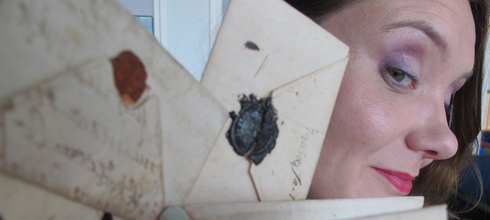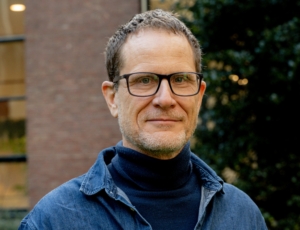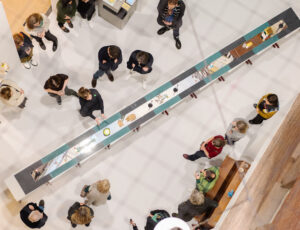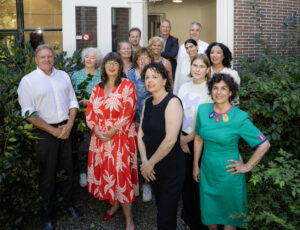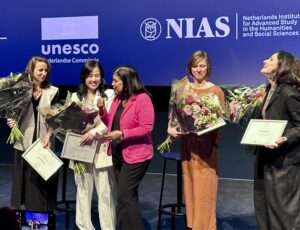Signed, Sealed, & Undelivered
The trunk contains 2,600 letters sent from France, Spain and the Spanish Netherlands between 1689 and 1706 but never delivered – including 600 letters never opened – because their recipients could not be found or would not pay outstanding postage costs. The trunk has been stored in The Hague’s Museum voor Communicatie since 1926. An international team of experts from MIT, Yale University, and the Universities of Leiden, Groningen, and Oxford is exploring them to find out more in a ground-breaking project called Signed, Sealed, & Undelivered.
The trunk in which the letters were kept Photograph: Hague Museum for Communication
The researchers are employing a range of innovative techniques to explore these often complexly folded letters – and to read the unopened letters without breaking their seals. Using the latest advances in x-ray technology from the field of dentistry, the team will read the letters for the first time without damaging this unique archive. Dr Nadine Akkerman, from the University of Leiden, says: “Because early modern ink contained iron, incredibly delicate scanning can detect it on the paper. By scanning each layer of paper in a letter packet, we should be able to piece the letters back like jigsaw puzzles and read them without breaking the seals.”
Collected by the postmasters of the Dutch city of The Hague – Simon de Brienne and his wife Maria Germain – the letter-writers come from all levels of society, from aristocrats to wandering musicians, women as well as men, each with their own stories to tell. Beyond its written information, the trunk is a valuable physical resource, from the wax seals on its seal-skin-covered exterior to the ways the letters were folded.
Dr Daniel Starza Smith, from Lincoln College, University of Oxford notes: “How a letter was folded can express personality and period just as handwriting can.” Jana Dambrogio, conservator at MIT Libraries, adds: “But the inventiveness and complexity here is like nothing we have ever seen. It allows us to study what we call ‘letterlocking’: the tradition of folding and securing a writing surface to function as its own envelope. This is an entirely new area of study, so the trunk offers us amazing research opportunities.”
The collection includes letters from aristocrats, spies, merchants, publishers, actors and musicians. Photograph: Hague Museum for Communication
Dr David van der Linden, from the University of Groningen, says: “The collection contains unique letters sent between Huguenot family members, evincing the emotional strains of exile and separation. These Huguenot letters point to the emotional toll that displacement and migration could take in the early modern period – and still does today.” “So many of the concerns expressed in these letters are the same as today: parents worried about their children, wives angry at delinquent husbands,” adds Dr Rebekah Ahrendt, from Yale.
The Briennes were at the heart of European communications networks, serving William of Orange both before and after The Glorious Revolution of 1688, which saw William and his wife Mary depose King James II following a successful Dutch invasion of England, Scotland, and Ireland which shocked the world and changed Europe forever.
Koos Havelaar, Curator of Postal History at the Museum voor Communicatie, says: “Signed, Sealed, & Undelivered is a ground-breaking project which the Museum voor Communicatie is delighted to support. The historic postmasters’ collection of Simon de Brienne and Maria Germain will – for the very first time – reveal stories of everyday life from across seventeenth-century Europe. It shows how The Netherlands was at the heart of European communications systems, and offers an opportunity to study a unique cross-section of society. The trunk itself is one of the museum’s most spectacular treasures and we are delighted that we can at last reveal its fascinating contents. We look forward to putting on an exhibition and releasing a series of online resources in the near future.”
Further information
Please visit: www.brienne.org. The team is tweeting with the hashtag #signedsealedundelivered; or follow @letterlocking.
A paper dove included with one of the letters. Photograph: Hague Museum for Communication
About the Research Team
The research team comprises Dr Rebekah Ahrendt (Assistant Professor of Music, Yale University), Dr Nadine Akkerman (Lecturer in English, University of Leiden/ NIAS), Ms Jana Dambrogio (Thomas F. Peterson (1957) Conservator, MIT Libraries), Dr David van der Linden (Lecturer in History, University of Groningen), Dr Daniel Starza Smith (British Academy Post-Doctoral Fellow, Lincoln College, University of Oxford), and Mr Koos Havelaar (Director, Museum voor Communicatie, The Hague). They bring together a mixture of historical, archival, and linguistic approaches, and draw particularly on recent insights of conservation practice.
The project has received funding from MIT Libraries and the Netherlands Organization for Scientific Research (NWO), in order to begin conserving and cataloguing these letters. In the next stages of the project the opened letters will be transcribed, translated, and edited. Finally, the unopened letters will be scanned using x-ray tomography, an extremely sensitive technique from the field of dentistry, which has already been used successfully on some of the Dead Sea Scrolls.
